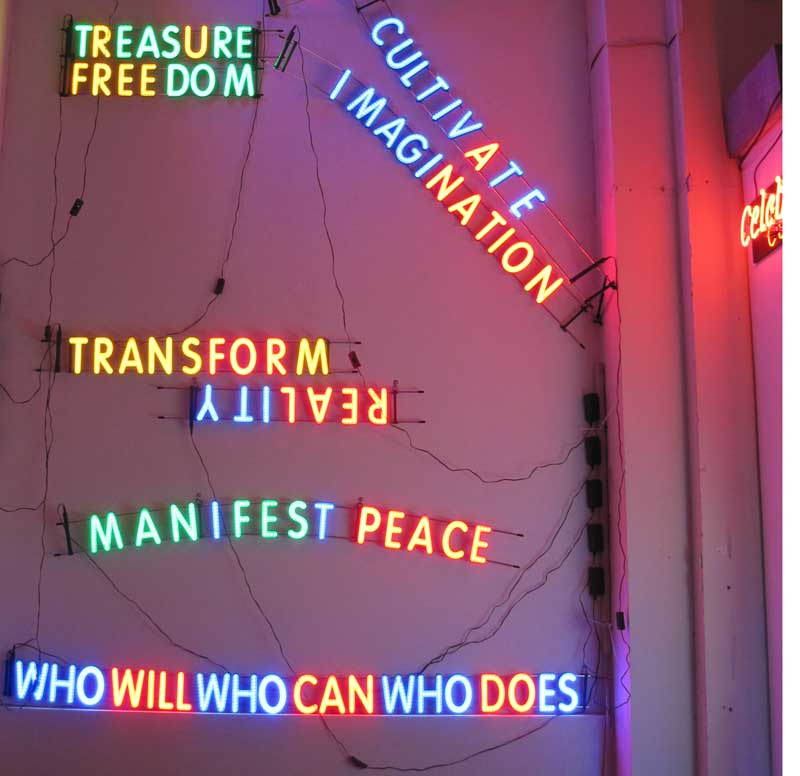Museum of Neon Art displays glowing exhibits by light artists

The Museum of Neon Art in downtown Los Angeles features a collection of vintage neon signs dating back to the ’20s as well as other works by light artists.
By Nicholas Williams
April 26, 2010 9:09 p.m.
Tantalizing our eyes since the ’20s, neon signs and their glow have decorated store windows, movie theaters and our streets. But there are a few artists that have taken neon and used it in an entirely innovative manner to create dazzling light art. The Museum of Neon Art, located on 136 W. 4th St., has been showcasing historic neon signs and neon artists’ work since 1981.
Despite the fact that neon has served as an advertisement tool and artist’s medium, it is a byproduct of several innovations: electricity, identifying and isolating the noble gases, and creating a vacuum. France was actually the first to use neon signs for advertising purposes, and it was later brought to the U.S. by an American entrepreneur.
“An entrepreneur from Los Angeles, Earle C. Anthony, was visiting France and saw an example of a neon sign, fell in love with it, and had to have it for one of his dealerships. … That was the first neon sign in America,” said museum curator Kim Koga.
It wasn’t until the ’60s that artists first started using neon.
“When the ’60s came, artists were looking to try new materials and, interestingly enough, neon was falling out of favor for the sign industry (in the ’60s) but artists started using it. Two artists, coincidentally both Greek immigrants, started, around the same time, using neon purely for art,” said Koga.
According to museum historian Eric Lynxwiler, neon, unlike paint, marble, clay or other common artistic mediums, requires more than just artistic talent.
“The medium is as malleable as paint; you just got to have a … lot of talent because not only do you need artistic talent, but you also need knowledge of chemistry and electricity,” he said.
Neon art requires not only extensive knowledge of how noble gases and the principles of electricity interact, but using neon to create a masterpiece is also a feat in itself.
“It’s (art) connected to science. As we say, you might be the best glassblower in the world but if you can’t get it to light up, it’s not neon,” said Koga.
In spite of the extra obstacles that come with neon art, artists are not discouraged from getting their hands dirty.
“Neon is eye candy. It has a beauty and function which is very attractive to me as a conceptual kinetic artist. It is a medium the public is used to looking at which gives me the perfect opportunity to throw (public viewers) a conceptual, visual curve,” said artist Joella March, whose art has been exhibited at MONA for the past five years.
Neon is not only a visually enticing medium, it elicits a sense of nostalgia for viewers.
“The innate trashiness of neon always appealed to me. My early experience in Las Vegas in the mid ’60s, the ’60s light shows at the Shrine Exhibition Hall, Tom Wolfe’s article about neon in Vegas, and LACMA’s Art and Technology exhibit in 1971 all had a major influence on me,” said light artist Bill Concannon.
Although MONA showcases neon artists such as prominent light artist Bruce Nauman, MONA’s biggest attractions are its vast collections of neon signs.
“People generally come to MONA for the signs; we do have some that go back to the ’70s, but we have several that date back to the 1920s. It’s only one half of what the museum is but it draws a lot of people,” Lynxwiler said.
MONA also offers guests a unique tour called the “Neon Cruise” that gives viewers a whole new perspective of Los Angeles.
“The goal of this tour is to take people out into the city of Los Angeles on a convertible double-decker bus and to ride them around town and show them all these great illuminated signs or art pieces that they have never even known existed,” Lynxwiler said.
Neon is an unconventional medium but now faces competition from newer technologies.
“Fiber optics and LEDs are a competitive medium to neon, but I think the inherent nature of neon as glass and light and gas will continue to be used as a medium with artists using traditional and avant-garde concepts and ideas to continue to challenge and push neon forward,” March said.


